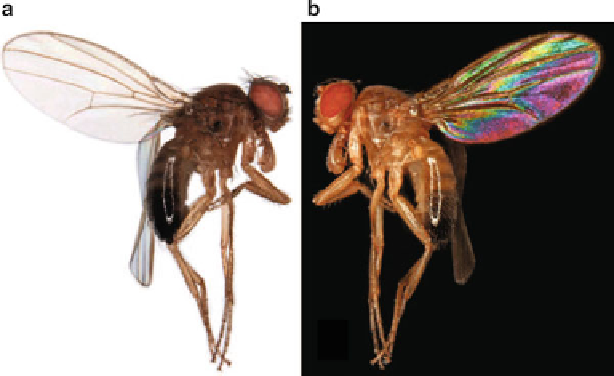Biomedical Engineering Reference
In-Depth Information
Fig. 8.7
Male
Drosophila melanogaster
on
white
(
a
)and
black
(
b
) backgrounds. (Reproduced
from [
38
])
black background (eliminating the disturbance of reflected light from backgrounds)
since about 20% of incoming light can be reflected by the wing membranes.
The thickness of the wing membranes is about several hundred nanometers, ideal
for thin-film interference, and varies with wing positions. As a result, positions
with different thicknesses produce different structural colors, giving rise to specific
structural-color patterns. The visibility of these color patterns is affected by the way
the insects display their wings against backgrounds.
Interestingly, the wings of small Hymenoptera and Diptera almost universally
display stable and non-iridescent structural-color patterns that are often taxon-
specific [
38
], as shown in Fig.
8.8
. In other words, these color patterns are visible
as well as stable over a wide range of perspective angles. The non-iridescence of
the wing structural colors can be understood by the surface morphology of the wing
membrane. The membrane surface is uneven with corrugations and dense setae. The
corrugations and setae may reduce or even eliminate the iridescence. This is because
the existence of the corrugations and setae could cause random scattering, leading
to non-iridescence over a wide range of viewing angles.
Another example of structural coloration caused by a single thin film is the
iridescent neck feathers of domestic pigeons (
Columba livia domestica
). In spite of
a long study history [
15
,
39
,
40
], the detailed origin of their structural coloration was
uncovered until recently [
41
-
43
]. Basically, there are two kinds of iridescent neck
feathers: one is green and the other is purple under normal perspective, as shown
in Fig.
8.9
. Like many other bird feathers, each iridescent neck feather consists of a
central rachis with an array of barbs projecting on both sides. On each side of a barb
there is an array of barbules. Each barbule is composed of successively connected
segments. The perceived iridescent green and purple colors arise from barbules.
Barbs do not possess any iridescent color.

